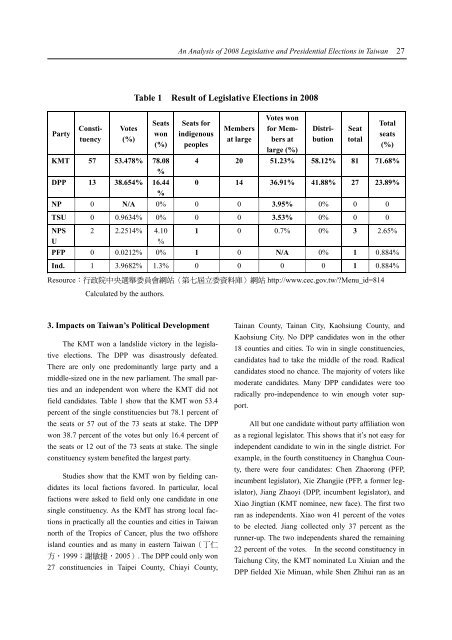PDF(2.7mb) - 國家政策研究基金會
PDF(2.7mb) - 國家政策研究基金會
PDF(2.7mb) - 國家政策研究基金會
You also want an ePaper? Increase the reach of your titles
YUMPU automatically turns print PDFs into web optimized ePapers that Google loves.
An Analysis of 2008 Legislative and Presidential Elections in Taiwan 27<br />
Party<br />
Constituency<br />
Votes<br />
(%)<br />
Table 1 Result of Legislative Elections in 2008<br />
Seats<br />
won<br />
(%)<br />
Seats for<br />
indigenous<br />
peoples<br />
Members<br />
at large<br />
Votes won<br />
for Members<br />
at<br />
large (%)<br />
Distribution<br />
Seat<br />
total<br />
Total<br />
seats<br />
(%)<br />
KMT 57 53.478% 78.08 4 20 51.23% 58.12% 81 71.68%<br />
%<br />
DPP 13 38.654% 16.44 0 14 36.91% 41.88% 27 23.89%<br />
%<br />
NP 0 N/A 0% 0 0 3.95% 0% 0 0<br />
TSU 0 0.9634% 0% 0 0 3.53% 0% 0 0<br />
NPS<br />
U<br />
2 2.2514% 4.10<br />
%<br />
1 0 0.7% 0% 3 2.65%<br />
PFP 0 0.0212% 0% 1 0 N/A 0% 1 0.884%<br />
Ind. 1 3.9682% 1.3% 0 0 0 0 1 0.884%<br />
Resource: 行 政 院 中 央 選 舉 委 員 會 網 站 〈 第 七 屆 立 委 資 料 庫 〉 網 站 http://www.cec.gov.tw/?Menu_id=814<br />
Calculated by the authors.<br />
3. Impacts on Taiwan’s Political Development<br />
The KMT won a landslide victory in the legislative<br />
elections. The DPP was disastrously defeated.<br />
There are only one predominantly large party and a<br />
middle-sized one in the new parliament. The small parties<br />
and an independent won where the KMT did not<br />
field candidates. Table 1 show that the KMT won 53.4<br />
percent of the single constituencies but 78.1 percent of<br />
the seats or 57 out of the 73 seats at stake. The DPP<br />
won 38.7 percent of the votes but only 16.4 percent of<br />
the seats or 12 out of the 73 seats at stake. The single<br />
constituency system benefited the largest party.<br />
Studies show that the KMT won by fielding candidates<br />
its local factions favored. In particular, local<br />
factions were asked to field only one candidate in one<br />
single constituency. As the KMT has strong local factions<br />
in practically all the counties and cities in Taiwan<br />
north of the Tropics of Cancer, plus the two offshore<br />
island counties and as many in eastern Taiwan( 丁 仁<br />
方 ,1999; 謝 敏 捷 ,2005). The DPP could only won<br />
27 constituencies in Taipei County, Chiayi County,<br />
Tainan County, Tainan City, Kaohsiung County, and<br />
Kaohsiung City. No DPP candidates won in the other<br />
18 counties and cities. To win in single constituencies,<br />
candidates had to take the middle of the road. Radical<br />
candidates stood no chance. The majority of voters like<br />
moderate candidates. Many DPP candidates were too<br />
radically pro-independence to win enough voter support.<br />
All but one candidate without party affiliation won<br />
as a regional legislator. This shows that it’s not easy for<br />
independent candidate to win in the single district. For<br />
example, in the fourth constituency in Changhua County,<br />
there were four candidates: Chen Zhaorong (PFP,<br />
incumbent legislator), Xie Zhangjie (PFP, a former legislator),<br />
Jiang Zhaoyi (DPP, incumbent legislator), and<br />
Xiao Jingtian (KMT nominee, new face). The first two<br />
ran as independents. Xiao won 41 percent of the votes<br />
to be elected. Jiang collected only 37 percent as the<br />
runner-up. The two independents shared the remaining<br />
22 percent of the votes. In the second constituency in<br />
Taichung City, the KMT nominated Lu Xiuian and the<br />
DPP fielded Xie Minuan, while Shen Zhihui ran as an

















